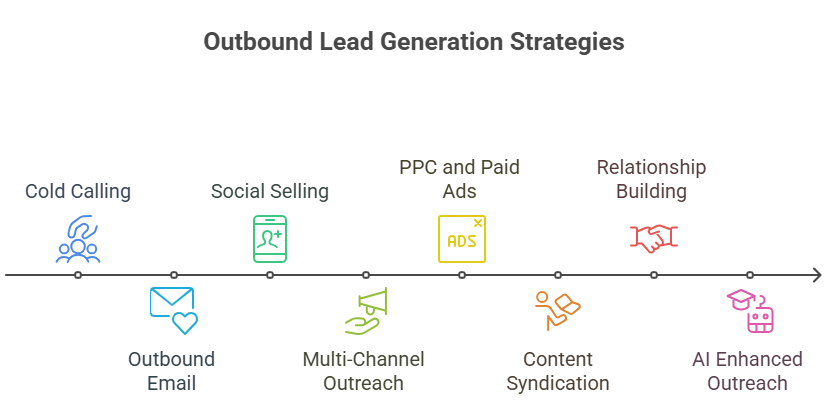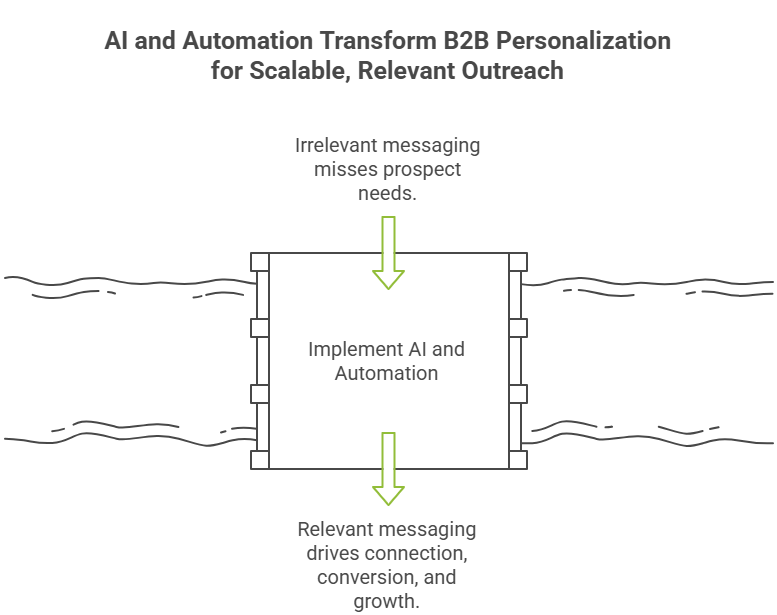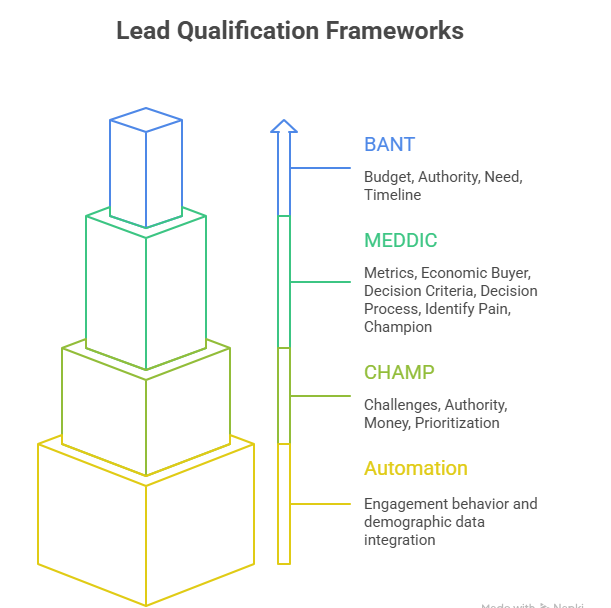What separates a barely-noticed cold email from a sales call that lands the big meeting?
Outbound lead generation starts with a question every B2B seller faces: How do you reach the right decision makers at the moment they’re ready to engage?
Today, buyers are flooded with pitches, and companies are more protective of their time than ever.
Committees form, circles of influence widen, and channels multiply.
So, relying on a single tactic is risky business. You need precision targeting, a mix of outreach tools, and messages crafted for the real humans behind the job titles.
The winners in this space treat outbound as a blend of storytelling, data science, and genuine curiosity, multiplying touchpoints and adapting fast.
Ready to go beyond the spray-and-pray era? Let’s rethink the outbound for the decision-maker ecosystem that defines B2B today.
Outbound lead generation is all about making the first move. Instead of waiting for prospects to discover your brand, your team reaches out, sometimes through cold emails, LinkedIn connections, phone calls, or digital ads, to engage decision makers who may not know you yet.
Think of it as “push” or interruption marketing, where your business actively introduces solutions to potential buyers and sparks interest before they start looking.
Contrast that with inbound marketing, which is “pull” or permission-based. Inbound draws prospects in with valuable content and resources, attracting those who are already searching.
Why outbound? In complex B2B fields like SaaS, medtech, consulting, and agencies, waiting passively often means missing serious opportunities.
Outbound puts you in control, letting you reach key decision makers directly, even before they realize they have a need.
Outbound is precise and proactive. It’s perfect for:
Yes, outbound interrupts the buyer’s flow, but it does so thoughtfully, creating genuine conversations that inbound alone can’t achieve. While both inbound and outbound have their place, mastering outbound means mastering the art of reaching out at the right time and with the right message.
How can you make sure your outreach hits the mark? Let’s break down what outbound lead generation really means today and how it fits into winning B2B strategies.
Outbound lead generation is a multifaceted process, and the right mix of services and platforms can make all the difference between guesswork and consistent results. What should you expect from each type of solution?
Many businesses partner with full-service providers. These companies handle everything from list building to outreach design to lead qualification. They save you time and bring deep expertise, but it comes with a premium price tag, essential for companies that want a hands-off yet effective approach.
Data vendors are the backbone for outreach lists. They supply contact info, firmographics, and intent signals that keep your campaigns focused and relevant. Reliable data matters; poor lists lead to wasted time and lower conversions. Vetting vendors is crucial before commitment.
Then there are Sales Development Representative agencies, specializing in personalized outreach on your behalf. Outsourcing SDR tasks, including calls, emails, and social touches, frees your internal teams to concentrate on closing qualified leads. This hybrid model combines scale with personal touch.
Next, automation platforms streamline campaign workflows, tracking, and reporting. But 2025 brings new challenges: traditional cookie-based tracking is fading fast. How do you maintain data clarity?
You can also check out cookie-agnostic solutions like CausalFunnel. This platform uses AI and a privacy first design to track complete customer journeys without relying on cookies. It integrates smoothly with your CRM and marketing automation, enabling real-time funnel visualization, accurate attribution, and automated A/B testing, all while respecting compliance.
To keep it simple, here’s what outbound success looks like with the right services:
Choosing the right combination depends on your team size, budget, and goals. But blending these elements strategically moves outbound lead generation from a guessing game to a calibrated growth engine.

Outbound lead generation has come a long way from the days of dialing endless numbers or sending bulk emails that barely got opened. Today, businesses have more sophisticated tools and methods to reach the right audience at the right moment.
The challenge? Picking the right mix of strategies and executing them with precision. Let’s walk through some of the most effective approaches and explore how they can be applied in practice.
Cold calling is still alive, and it works when done thoughtfully. It is no longer about blasting through a contact list. Instead, successful cold callers:
When handled with empathy and insight, cold calling opens conversations that digital channels often miss.
Cold email remains the workhorse of outbound efforts. It is scalable, cost-effective, and quick to deploy. But sending out templated messages is not the way forward. The best results come from:
A carefully built list combined with ongoing testing ensures higher engagement.
If you want to meet prospects where they already spend time, social platforms, especially LinkedIn, are ideal. Social selling is not about spamming DMs. It is about:
This approach can warm up leads before direct outreach, reducing friction in later conversations.
One channel alone rarely carries the load. Buyers expect to hear from you in more than one way. Multi-channel outreach may include:
The more consistent and connected the touchpoints, the higher the chance of building trust.
Paid advertising speeds up awareness when organic reach takes time. Well-targeted campaigns on platforms like Google or LinkedIn can:
For outbound campaigns, PPC works best as a complement to emails and calls, not as a standalone tactic.
Great content should not stay hidden on your own website. Content syndication expands your reach by distributing resources such as case studies, whitepapers, or industry guides through external platforms or email campaigns. It helps:
This method works especially well for companies selling complex B2B solutions where education plays a big role in the buyer journey.
Outbound outreach often fails when it feels robotic. Building real relationships is what turns a cold prospect into a warm lead. This means:
Relationships are built over time, and thoughtful personalization shows respect for the prospect’s priorities.
Artificial intelligence is changing outbound lead generation at its core. With AI tools, businesses can:
It adds speed and accuracy to a process that used to rely heavily on guesswork.
This is where platforms like CausalFunnel make a difference. Businesses can:
Instead of juggling disconnected tools, companies get an integrated way to elevate every outbound strategy and measure what truly works.
Defining your Ideal Customer Profile or ICP is the secret weapon for outbound lead generation success. But what exactly goes into a strong ICP? It is way beyond just demographics.
You want to capture who benefits most from your product, who buys repeatedly, and who fits your long-term vision. This clarity frees your team from wasting time chasing every possible lead.
Start with the data you already have. Look at your current best customers and identify shared traits:
Next, headphones on and talk to those customers. Interviews and surveys uncover deeper insights, like what triggered their purchase and what stalled progress. Ask questions that draw stories, not just checkbox answers. For example:
This combination of quantitative firmographics and qualitative feedback sharpens ICP accuracy. Keep in mind, ICP is a living model, not a document to file. Update regularly with real world data and AI driven insights from platforms like CausalFunnel that analyze customer behavior patterns dynamically.
Once you know your ICP, start building and enriching your contact lists. Use trusted B2B data platforms like ZoomInfo, Apollo, LinkedIn Sales Navigator, and Cognism. These tools help you:
Compliance is non-negotiable. Ensure your data sourcing respects opt-in requirements and regional laws like GDPR and CCPA. Always be transparent with prospects about data use to build trust early.
By nailing ICP and list building, your outbound campaigns become targeted, efficient, and effective. This sets the stage for higher conversion and deeper relationships.
Orchestrating a multichannel outbound campaign today means weaving together calls, emails, social media, SMS, and events into a seamless dance of engagement. Why settle for one touchpoint when decision makers respond better to a coordinated symphony of outreach?
Here’s how to compose your campaign for resonance and response.
Cold Calls
Emails
Social Selling
Events
Paid Advertising
Content Syndication
Personalisation & Relationships
AI-Enhanced Outreach
Multichannel outbound campaigns are about more than just spreading your message far and wide. They require carefully timed, coordinated touches across emails, calls, LinkedIn, SMS, and events, all tailored to your audience’s journey. Why? Because decision-makers engage differently, and hitting them at the right time on their preferred platform multiplies your chances of connection and conversion.
Start with a clear campaign plan. Define your goal and segment your ICP into tightly targeted groups. Each group deserves a customized message and sequence, not a generic one-size-fits-all blast. For instance, a CFO’s concerns differ vastly from those of an IT leader. Your outreach should mirror those differences.
Cadence matters. A thoughtful sequence might look like this:
Multichannel means flexibility. If one channel isn’t working, you pivot, leveraging others to keep the conversation alive.
Templates and personalization are your best friends. Create email and message templates that are modular so sections can be swapped out for job titles, industries, or pain points. Use tool driven dynamic content to insert customer specific details automatically, making mass outreach feel individual and thoughtful.
Now, compliance is a must, especially under GDPR and CCPA. Always:
Ignoring these rules slides campaigns into legal gray zones and erodes trust faster than cold calls ever will!
Content marketing and nurture paths serve as the gentle heat that transforms cold outbound leads into warm prospects eager to engage. But how exactly do you craft this journey? The blend of ebooks, webinars, podcasts, and automation creates an ecosystem that keeps your brand top of mind while educating and building trust.
Consider ebooks and whitepapers as foundational content gifts. These authoritative resources dive deep into industry challenges and solutions, giving prospects a reason to pause and explore.
Webinars add real-time interactivity, letting experts address questions and showcase expertise live. They are perfect for nurturing leads who prefer dialogue over reading. Podcasts give a chance to share stories and insights while prospects multitask, extending your reach in a personal yet unobtrusive way.
Automated nurturing is the engine behind this warmth. Set up multi-stage email sequences that adjust based on behavior triggers. Did a prospect download your latest guide? Automatically send a relevant webinar invite. Did they attend a session? Follow up with a case study or one-on-one consultation offer. These sequences are not static; they evolve as leads interact or stall.
What about combining inbound content with outbound momentum? Outbound outreach introducing your company can include links to valuable inbound assets, encouraging prospects to self-educate before committing. This synergy aligns with how buyers research independently before engaging sales.
Key principles to keep in mind:

Personalization used to mean adding a name to an email. Today, it’s a strategic powerhouse, driven by AI and automation, that transforms how B2B teams engage thousands of prospects with remarkably relevant messaging. But how exactly does AI help you personalize outreach at scale without losing the human touch?
AI analyzes mountains of data such as firmographics, web behavior, and content engagement to predict what matters to each prospect.
This allows you to customize messages not just by job title or company size, but by real-time interests and challenges. For example, an IT director who recently viewed a security whitepaper will not get the same pitch as a CFO browsing pricing pages.
Automation platforms execute these insights by managing multi-step campaigns where messages dynamically shift based on recipient actions. Imagine sending a case study after a webinar registration or switching from email to a chatbot interaction when prospects show high interest. These smart triggers keep prospects engaged without overwhelming them.
Where does CausalFunnel step in? It powers AI-driven variant testing, letting you experiment with different messaging variations and identify what resonates best.
Its DeepID user tracking replaces traditional cookies with privacy-conscious, behavior-based profiles, giving a clearer picture of who interacts with your outreach and how. Automated split testing continuously refines campaigns while easing marketers’ workloads.
In short, AI and automation help businesses:
Have you considered how combining this technology with your outbound strategy can accelerate connection, conversions, and growth? With AI-powered personalization, your outreach truly becomes a conversation tailored for each buyer’s journey.

Qualifying leads isn’t guesswork. It’s science, structured through proven frameworks like BANT, MEDDIC, and CHAMP that help sales teams identify who’s worth chasing and when. Each framework evaluates key factors such as fit, intent, authority, budget, timing, and need to prioritize prospects effectively.
BANT focuses on Budget, Authority, Need, and Timeline. It’s simple and fast, ideal for shorter sales cycles. You quickly assess whether a prospect has the funds, decision power, a pressing need, and the right timeline. But does BANT capture complex buying behaviors? Not always.
Enter MEDDIC, a comprehensive system covering Metrics, Economic Buyer, Decision Criteria, Decision Process, Identify Pain, and Champion. It’s perfect for enterprise deals with multiple stakeholders and longer cycles. MEDDIC digs deeper into the decision-making journey, helping you find internal champions and understand every buyer criterion.
CHAMP centers on Challenges, Authority, Money, and Prioritization. It blends relationship focus with qualification, emphasizing the buyer’s pain points and priorities, great for consultative sales.
Modern sales don’t live in silos, so smart teams combine these frameworks to fit their unique context, streamlining qualification and increasing wins.
Automation boosts qualification accuracy and speed. Sales and marketing platforms now integrate signals from engagement behavior to demographic data to trigger lead scoring and alerts. You might have a system marking a lead as hot after downloading a key asset or attending a webinar.
In today’s privacy-first world, understanding compliance isn’t optional; it’s essential. Regulations like GDPR in Europe, CCPA in California, and HIPAA in the healthcare sectors govern how you collect, store, and use customer data. Ignoring these rules risks heavy fines and irreparable reputation damage.
Ethical outreach means respecting user consent and transparent communication. Ask: Have you clearly informed prospects what their data will be used for? Do you offer simple, accessible opt-out methods? Maintaining trust keeps doors open for future engagement.
Cookies, once central for tracking, are fading. What replaces them? Cookie-less attribution technologies are rising, using AI and fingerprinting methods that respect privacy while delivering accurate funnel insights.
CausalFunnel exemplifies compliance-first funnel optimization. It uses cookie-agnostic tracking to map customer journeys without compromising personal data. This reduces privacy risk while enabling you to measure marketing impact comprehensively.
When ethical practices align with sophisticated technology, outreach becomes more than just compliant, it becomes a competitive advantage.
Inbound and outbound marketing define two distinct paths to reach buyers. Inbound is like a magnet, pulling prospects in with valuable content, optimized experiences, and ongoing engagement. Outbound is the proactive push, actively seeking and introducing your solution to potential buyers who may not know they need it yet.
Inbound relies on content such as blogs, social media, SEO, and webinars that educate and nurture an audience over time. Outbound uses channels like cold calls, mass emails, paid ads, and direct messages to ignite conversations quickly.
Each has strengths and constraints:
Why choose? Often, the winning formula is a well-crafted blend.
Hybrid funnels combine inbound’s education and engagement with outbound’s targeted precision. For instance, outbound campaigns might send prospects to inbound assets like ebooks or webinars to nurture interest, creating a seamless journey from cold outreach to warm engagement.
How to build this funnel?
You cannot improve what you don’t measure. The key to maximizing outbound impact lies in precise tracking and clear visualization of every funnel step.
Track KPIs by:
Attribution models matter. First-touch, last-touch, and multi-touch attribution help determine which campaigns contribute most to revenue.
CausalFunnel bridges reporting gaps. Its live dashboards unify data from calls, emails, chats, and ads into an intuitive interface. DeepID tracking replaces cookie reliance, ensuring accurate, privacy-compliant tracking across devices and sessions. This clarity reveals drop-off points and high-performing touchpoints instantaneously.
With real-time funnel insights, marketers can pivot quickly, optimize messaging, and allocate budget smartly. Automated alerts flag hot leads proactively, guiding sales teams where to focus.
Outbound lead generation remains essential, especially in B2B. Success depends not just on reaching prospects but on expertise, personalization, multichannel orchestration, data insights, and AI powered automation. Are you applying all these effectively?
CausalFunnel supports this journey by combining advanced A/B testing, ad optimization, and intelligent chatbot engagement to streamline and enhance both inbound and outbound outreach. Its privacy-first approach ensures compliance without sacrificing performance.
Here’s a gentle nudge:
By utilising these tactics and tools, your outbound strategy transforms from scattershot outreach to a precision engine driving sustainable growth. Ready to take your outbound lead generation to the next level? Get your free trial now!
Empowering businesses to optimize their conversion funnels with AI-driven insights and automation. Turn traffic into sales with our advanced attribution platform.



